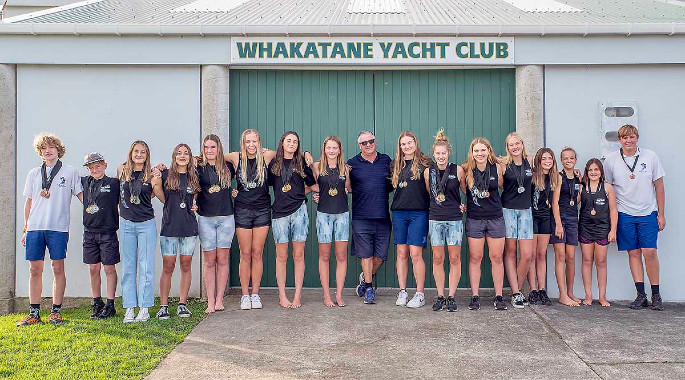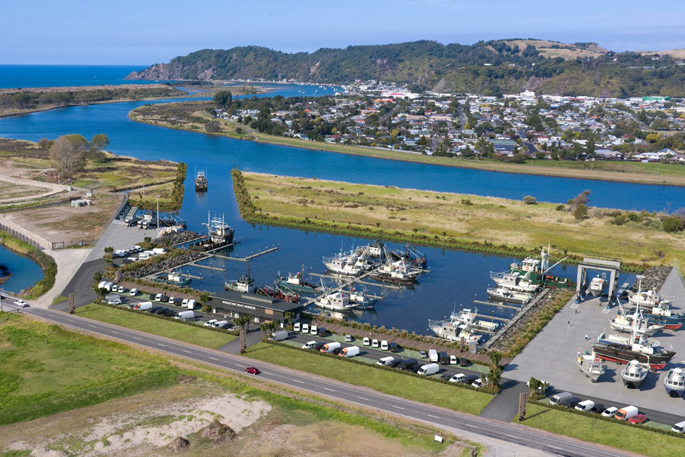Conflicts with existing river users, including waka ama, kayak paddlers and rowers are among the concerns expressed by Whakatāne Yacht Club to the consent panel for Whakatāne's proposed commercial boat harbour.
One of the concerns is that wake from boats using the channel to access the harbour could make the area of river between the current town wharf and the Landing Road bridge unusable for smaller, flatwater craft that now have that part of the river largely to themselves.
Clubs that would be affected include Whakatane Rowing Club, Eastern Bay Canoe Racing Club and Waka Ama o Whakatāne.
Whakatāne Yacht Club raised the issue among its comments to the Environmental Protection Authority's fast track consent panel and the rowing club is in the process of putting together a submission.
The panel of Graeme Mathias - chairperson, Sheena Tepania and David Hill was appointed in February and in March invited 26 individuals and groups to comment on the application from Te Rāhui Herenga Waka Whakatāne to develop a commercial boat harbour at 2 Keepa Road, including a marina, berthing infrastructure, a commercial maintenance facility and an access channel to the river.
The yacht club shared some initial concerns about river sediment dynamics and the possibility of river sediment from the access channel resettling downstream into other areas, including its own marina; and the impact of the proposed stage two recreational berthage on the club's own privately funded marina, which it already has plans to expand.
The club sought the application be declined unless the recreational berthage was removed from the consent and a quantitative assessment undertaken of the effects of the access channel usage.
It also expressed disappointment in the short timeframe for organisations to make adequate consideration of the huge amount of information provided in the application.
Given further opportunity to comment, a submission, signed by club commodore Jim Williamson and marina manager Barry Cutfield, was sent on May 18 conveying concerns about the access channel that will be dredged to allow boats to travel more than three kilometres upriver to the marina.
 Eastern Bay Canoe Racing Club members. Photo: Whakatāne Beacon.
Eastern Bay Canoe Racing Club members. Photo: Whakatāne Beacon.
It said the group that would be most affected by the access channel would be the Eastern Bay Canoe Racing Club, which is based at the Whakatane Yacht Club and at the Eivers Road boat ramp.
'The 30-strong contingent of young flat-water canoe racers and coaches ply the waters of the Whakatāne River from the entrance to the Whakatāne bridge,” the letter said. They use K1 flatwater kayaks which are simply unmanageable in waves greater than 150mm. This is a critical safety issue.”
Attached was an article published on May 11 showing the recent successes of the club, mentored by Dame Lisa Carrington, at last month's New Zealand Canoe Sprint Championships at Lake Karapiro, where it won 33 medals.
'The photograph shows the faces of the young folk who will be displaced from their training waters by the traffic in the Whakatāne Commercial Boat Harbour access channel, and the vessel wakes propagating across the silt banks in the remainder of the river channel.”
Canoe racing club president Hamish Reid told Local Democracy Reporting his biggest concern would be the number of boat movements going backward and forward from the three-and-a-half kilometres from the proposed marina to the harbour entrance.
'You can imagine the wash coming up from that. None of that has been really communicated out when they asked for feedback. There's also talk of having a boat ramp there eventually, so if you add trailer boats, that's a lot of boat movements.”
While the Whakatane Rowing Club is located upstream from the proposed harbour, and thereby less affected by the boat traffic, club president Steve Brine said it would make a big difference to rowers.
"It will have some effect because we row down that way and we will obviously run into the traffic of big boats, which we try to avoid. We row down one side of the river and up the other side, because that's maritime law. You can't just row anywhere on the river. Because we're rowing backwards it's even more important," says Steve.
"It will create more boat traffic because there is very little boat traffic at the moment. So, there is about one and a half kilometres of water that is going to see an increase of boat traffic. I'm assuming they won't go any further up because it won't be deep enough, but you never know.
"We had one communication, probably three years ago. Since then, we've had nothing. I talked to the person at the time and said, well obviously we row down that far, so there will be traffic issues from our perspective," says Steve.
"We'd like to understand it. A lot of people say, well, we could just row above the bridge, which we could, but it just cuts down our options at different times of the tides. A lot of that downstream part of the river is quite shallow. People think it's usable but quite often it's not.
"This club has been here since 1953. It's been there since before there was a bridge there. It was originally located down at the wharf there. And moved because of the traffic issues," says Steve.
He says no one from the harbour project had made any attempt to communicate with the club.
'It could all be manageable, but until someone tells us how it's manageable, we only need one fairly large boat coming in with a large wash and it could create really bad issues.”
Boat harbour project manager Phil Wardale says the channel between the harbour and the river entrance would be a five knot or no wake zone that should not cause problems for other river users.
The panel intends to issue its decision on the resource consent application for the Whakatāne Commercial Boat Harbour project by Thursday, June 23.
Submissions pour in for boat harbour project
Increased traffic between the Whakatāne bridge and river mouth, river sediment dynamics and lines of sight between local marae and Kapu te Rangi are just some of the concerns raised by submitters to the consent panel for the proposed boat harbour.
Individuals and groups invited to make submissions to the Environmental Protection Authority's fast track consent panel included Whakatāne District Council, Bay of Plenty Regional Council, Te Rūnanga o Ngāti Awa, 11 customary marine title and protected customary rights groups, and owners and occupiers of 48 properties adjacent to the proposed harbour.
Other groups considered appropriate by the panel to approach for submissions included recreational users such as the Rowing Club, Waka Ama o Whakatāne, Whakatāne Sportfishing Club and coastal permit holders like Whakatāne Yacht Club, Maritime New Zealand, Horizon Energy, and the Whakatāne harbourmaster.
Te Rāhui Herenga Waka Whakatāne project director Phil Wardale lodged the consent application with the Environmental Protection Authority on February 1 to develop the commercial boat harbour at 2 Keepa Road, including a marina, berthing infrastructure, a commercial maintenance facility and an access channel to the river.
The application consists of 26 documents and includes a 133-page cultural report from Te Rūnanga o Ngāti Awa, scientific and engineers' reports on the effects on the river and surrounding area, a wetland restoration plan and much more.
The application was found to meet requirements set out in the Covid-19 Recovery Act 2020 to be fast-tracked through the consent process. The process requires a consenting panel to invite written comments from specific individuals or groups.
The panel of Graeme Mathias (chairman), Sheena Tepania and David Hill was appointed on February 28 and on March 18 invited 26 individuals and groups to comment. A response had to be sent in by April 8, and 27 individuals and organisations responded in that time.
Several unsolicited submissions against the boat harbour were also received from a group formed on April 5, called Pupuaruhe ki te Rahui. While the panel originally decided it was not able to accept the submission as the group did not meet the qualifications, the panel later allowed other submitters, including adjacent landowners, to update their submissions to include the submission from the Pupuaruhe ki te Rahui.
The panel also agreed to accept submissions from anyone who identified their connection with Te Hokowhitu a Tū ki te Rahui Marae, stating that this was not limited to the trustees or the 138 registered Māori landowners.
Among the objections from marae landowners was that the harbour buildings would block the view of significant wāhi whenua, including Ōhinemataroa (Whakatāne River) and Kapu te Rangi.
Mr Wardale, in his response to the panel, acknowledged the cultural values and associations of the site, the role of submitters as kaitiaki and the significance of the landscape and the viewshafts from the marae.
He said design and siting of buildings and structures would avoid imposing on views from Te Hokowhitu a Tū ki te Rāhui Marae towards Kohi Point and to the pa called Kapu Te Rangi above the Wairaka cultural precinct, to the east and north-east respectively.
-Local Democracy Reporting is Public Interest Journalism funded through NZ On Air




1 comment
harbour
Posted on 09-06-2022 16:01 | By dumbkof2
what a funny name for a boat harbour. no indication of where it actually is or even what country it is in
Leave a Comment
You must be logged in to make a comment.